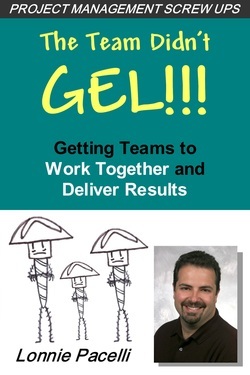Lonnie Pacelli's Blog, page 63
March 5, 2016
Lesson 24 - Scope addition: more money, more time
 Six-Word Lessons for Project Managers on Amazon, kindle, iTunes, Nook and moreScope additions without budget or schedule impact mean less contingency or overworked teams.
Six-Word Lessons for Project Managers on Amazon, kindle, iTunes, Nook and moreScope additions without budget or schedule impact mean less contingency or overworked teams.Know how scope additions will be funded and how they impact project schedule before saying yes.
See all 100 lessons at 6WordLessons.com
Published on March 05, 2016 02:47
The Five Biggest Mistakes a Human Resources Professional Can Make…From the Client’s Perspective
 A number of years back I was in a meeting with two HR representatives at my company.They were explaining to me how the HR organization wanted to be more “strategic” with its clients and how they wanted to help us with annual resource planning. At the time, our biggest problem was filling open positions with qualified candidates; a number of key positions had been open for months with no qualified candidates in the hiring pipeline. When I asked the HR reps about how they were going to help with this problem, they both told me that they didn’t have time to address the hiring issues because they were tasked with being more “strategic”. Needless to say, the meeting went downhill in a hurry because the HR reps were more interested in fulfilling the HR organization’s “be strategic” mandate than they were in helping me with my real-life problem.
A number of years back I was in a meeting with two HR representatives at my company.They were explaining to me how the HR organization wanted to be more “strategic” with its clients and how they wanted to help us with annual resource planning. At the time, our biggest problem was filling open positions with qualified candidates; a number of key positions had been open for months with no qualified candidates in the hiring pipeline. When I asked the HR reps about how they were going to help with this problem, they both told me that they didn’t have time to address the hiring issues because they were tasked with being more “strategic”. Needless to say, the meeting went downhill in a hurry because the HR reps were more interested in fulfilling the HR organization’s “be strategic” mandate than they were in helping me with my real-life problem. As a longtime client of numerous HR organizations, I’ve learned to appreciate the value that HR professionals provide and the times my HR partner protected me from potentially difficult situations. When working well, the client, employees, and company as a whole benefit. When things don’t work so well, though, everyone ultimately loses. Through my years as a client, I’ve locked down on five of the biggest mistakes that an HR professional can make in their relationship with the client, as follows:
Not understanding the client’s business – Foundational to an HR professional’s success is s strong understanding of their client’s business. What are the key products the client offers? What does the client want to accomplish in the next fiscal year? Is the client’s product emerging, stable, or declining? What are the client’s key business challenges? Does the client face any significant financial issues? Have the professional self esteem to know that the client wants you to invest some time to understand their business. Being a team player means spending time with the team to better understand how your services can be best applied in the client’s organization. Trying too hard to get the client to understand the business of HR – Many HR professionals I’ve worked with wanted to “educate” me on terminology, concepts, or the latest HR trends. While the education was interesting and helped broaden my horizons somewhat, much of the education wasn’t relevant to my job or important for me to know. If there are truly important terms and concepts that the client is going to need to know to get their job done effectively, then by all means educate away. However, if the HR-ese is not material to the client getting their job done, then skip the education session. Help the client with what is need-to-know and keep the rest in your bag of tricks. Not understanding the basics of employment law – My most valuable experiences with my HR partners were situations where my HR partner helped me to understand employment law issues and advised me on courses of action to take to minimize legal risk. When an HR professional understands the basics of employment law and can recognize situations where further legal advice may be required, potentially hundreds of hours of lost productivity are mitigated. By not having employment law basics down, the HR professional not only puts the client’s business at risk but also suffers a credibility hit in the client’s eyes. Know enough to advise the client and when additional legal help needs to be brought in. Showing bias in supporting either management or employees – A crucial credibility factor for an HR professional is demonstrating impartiality while dealing with HR issues. If an HR professional has a reputation for being biased toward management, then they get a rap for being a “company” person and potentially legitimate employee issues may never surface. Conversely, when the bias is toward the employee, then they can be accused of holding “witch hunts” against management. The best HR professionals walk this line carefully and ensure that their thought process and advice represents consideration of sound business and legal thinking. They also need to have the courage of their convictions to tell either management or an employee when and where they think they are going wrong. Don’t become a "yes man" or “yes woman” for either side.Not establishing expectations of work to be performed – Perceptions of the services an HR professional provides can be radically varied from client to client. While one client may see an HR professional as a recruiter, another may see the HR professional as an employment mediator, while a third may see him or her as an overall generalist. Establish a service-level agreement or contract with the client to ensure a common understanding of services performed, what is expected from the client, and expected timeframes in which services will be performed. Key to this is ensuring that the contract is mutually understood and agreed-upon; it’s not enough for the HR professional to quote department policy about what will or won’t be done for the client. Make it clear about what you’ll do for the client, what you expect from the client, and in what timeframe the work will be done. An HR professional that understands the client’s business, shields the client from the HR-ese, is unbiased, delivers against clearly set expectations, and protects the company and employee fairly can be an invaluable partner to both the client and the company as a whole. Avoid these five major mistakes and you’ll build a high degree of trust and credibility with your client, be viewed as a trusted business partner, and save potentially countless hours of lost productivity and waste.
Published on March 05, 2016 02:47
February 29, 2016
Subscribe to the Project Management Advisor and get 27 Tips to Conquer the Seven Deadly Sins Free

Subscribe to the Project Management Advisor Newsletter and get 27 Tips to Conquer the Seven Deadly Sins of Leadership
After you confirm you'll get a personal email from me (no robot stuff!) with your link. Subscribe today and let me help you be a better leader!
#mc_embed_signup{background:#fff; clear:left; font:14px Helvetica,Arial,sans-serif; } /* Add your own MailChimp form style overrides in your site stylesheet or in this style block. We recommend moving this block and the preceding CSS link to the HEAD of your HTML file. */
Published on February 29, 2016 20:54
The Team Didn't Gel! Getting Teams to Work Together to Deliver Results
 Making Beautiful Music Together…
Making Beautiful Music Together…I played the drums as a kid starting in 4th grade up into college. My family suffered through many hours (and headaches) of me beating the skins to jazz, funk, and rock music. When I started playing with the school band, I had to learn that making music wasn’t about how fast I could do flam-a-diddles or how loud I could play, but how I played in relation to the other band members. If the music called for adagio (slow & leisurely pace) it would be a bad idea to break into an In-A-Gadda-Da-Vida drum solo while everyone else is playing elevator music. The important thing was to match my playing to the other instrumentalists and to make beautiful music together. While I never got to rock stardom with my own entourage and groupies, I did learn that music is about how the entire band sounds not any individual player.
By now you’re probably wondering why I took a mental trip to Tahiti to tell you of my musical aspirations. To me, a well structured project team where each team member understands their role in making the project successful is like the musicians playing in a band. Each project team member knows what they need to contribute to the project, knows when they have to perform, understands what other project team members are doing on the project, and knows what it takes to be successful. Just as important, each of the project team members help each other to ensure overall project success.
How it happens
There was not a clear project organization with clearly defined roles –
This goes beyond a hierarchy chart. Each person needs to know what function they play on the team, how they fit into the other functions, and what happens if they don’t do their job.
Depending on your industry or functional discipline, there may be standard or customary roles that you employ on your project. There are a few things that I have learned, though, about project standard roles as follows:
Start with the standard or customary roles that are typical for your type of projects
If the project need warrants a special role which is outside of standard, then create a special role
If the project doesn’t need a standard or customary role, then eliminate the role
These may sound like overly simplistic statements, but I’ve been amazed over the years with seeing cumbersome project role structures because the project manager was reluctant to deviate from standard project roles. As experienced project managers, our job first and foremost is to make sure that the right people are assigned to do the right tasks to produce the right result at the right time. At the end of the day, I’ve never been graded on how well I adhered to a standard project role structure; I’ve been graded on results.
Get 27 Tips to Conquer the Seven Deadly Sins of Leadership with free newsletter subscriptionGet it Free!If the project environment doesn’t have standard or customary project roles or if I’m taking on a unique type of project, then I like to take a very pragmatic approach to role definition, as follows:
Define the 3-6 things on the project that I am most concerned about or pose the greatest risk to meCreate roles that encompass the concern or risk areasCross-check the roles with the work that needs to be done in the project schedule to ensure that all of the major roles are being defined correctlyBy doing this, I am addressing concern or risk areas head-on by defining a role with a singular point of accountability to manage the areas of my project that are most likely to fail. This technique has helped me on more than one project to sleep better knowing that I had my most crucial areas covered.
The team finger pointed and fought in public –
On any project you do, so long as there is more than one person involved, there are going to be lively discussions. When this happens, it is very likely that something good will come of the discussion and that in some way the project will move one step closer to the finish line as a result. On past projects I have managed, I was very deliberate about letting these discussions happen and in letting team members question each other. I did put a few rules in place, though:It’s very cool to challenge and stretch, but once we make a decision we need to get behind it as a teamWhat happens in the room stays in the room; outside of the room we are a unified teamIf we made a wrong decision we accept the decision as a team; no finger pointing allowedWe focus on the problem and not the person; don’t make the problem personalSo, were the rules followed 100% of the time? Sadly, no (myself included). After all, we are human. However, you should still strive to get some ground rules in place to avoid team strife where you can.
There was no “rallying cry” –
You can look at many major successful campaigns and pull some slogans from them which embodied the message behind the slogan; “Where’s the beef,” “Milk, it does a body good,” and “Plop, plop, fizz, fizz” are all unifying messages that cause you to think about a product. Similarly, when driving a project it helps the team to have some kind of a rallying cry or mantra that the team embodies when driving work. On one project, we wanted to be extremely cautious of not over-designing a solution and putting too many bells and whistles in to help us keep our costs down. We started using a “good enough” rallying cry during the design phase to be a continual reminder that we wanted to not overdo the solution. It worked incredibly well because the team would critically question itself with “is this good enough?” when looking at the architecture and functionality. Aside from helping to make sure our solution was cost effective, the rallying cry helped the team to better bond.
Team members weren’t held accountable for delivery –
With project teams, I firmly believe that each role needs to clearly understand what they need to do, when they need it by, and how their work fits into the big picture. I also firmly believe the project team isn’t only accountable to the project manager; they are accountable to each other since if any of the other roles fail the entire team fails. Given so, it is vitally important for each role to be visible as to what each other role is doing for the following reasons:Each role should be continually looking at other work that is happening to ensure that they know if and how they fit into the other workEach role should feel that if they miss a deadline or do not perform their job adequately, they are letting down the team as a whole, not just the project manager.Meeting or missing deadlines and deliverables are a team issue and should be exposed to the team. The point here is accountability. Each member needs to feel accountable for their work and needs to experience the joy of success as well as the discomfort of failure. The project manager needs to use discretion on making sure that things do stay constructive. Focus should be very much on how the team gets things back on track and moving forward versus badgering the team member.
In some instances, though, you may just have someone in a job who is not suited to perform. The project manager needs to deal with those situations swiftly because if he or she doesn’t, he or she is not doing his job, nor are they being accountable to the team by dealing with a problem performer.
The project manager wasn’t suited for the job –
The project’s needs and criticality to the business will be key drivers in the required experience level of the project manager. For relatively simple projects you may be able to staff the project with an inexperienced project manager with a more seasoned project manager serving as an occasional mentor. As projects increase in complexity and criticality to the business, though, there’s no substitute for an experienced, seasoned project manager.
I’ve been incredibly fortunate to have worked with some outstanding project managers over the years. In thinking about the best project managers, they’ve had the following things in common:They knew the techniques of project management coldThey knew (through experience) where they could bend the rules on the techniques to be able to buy time or be more efficientThey always kept things moving forwardThey knew when to shift from “let’s discuss” mode to “let’s decide” modeThey held others accountable to do their jobsThey praised successThey were excellent communicatorsThey took the heat for the team when external criticism happenedThey were calm and focused when things started going bad on a project and everyone else was wigging outI know of no magic formula for fitting the project manager for the job; what I can say is you’re better to err on having an over-experienced project manager versus an under-experienced one.
I knew of a very gung-ho young project manager (let’s just call him “Author”) who felt he was an outstanding project manager because he knew the techniques well (cost and schedule management, status reporting, etc.).
Because Author knew the techniques, he felt he could simultaneously take on three complex projects which really should have each had a dedicated project manager. Not only did Author learn some very valuable lessons, he unfortunately also cost his company a lot of money because others had to come in and mop up his mess. Both Author and I can’t stress enough to make sure your project manager is suited for the job.
The team didn’t celebrate wins –
Driving through a project is tough work. It is incredibly easy for people to get discouraged whenever the team hits roadblocks or has setbacks. It is vitally important for a team to celebrate hitting key milestones simply to keep morale up and keep project momentum. I’m not talking about three-day cruise type celebrations; it could be as simple as bringing in pizza or cake or something that allows people to let their hair down and take a bit of a breather. I would caution you about doing this too much; doing too much celebration lessens the effect of the celebration and could actually annoy your team members. I was on one project where people did not like the morale events because it only meant that they had to stay later that evening to get their work done. So, celebrate, but do it in moderation.
Warning Signs
The team shows confusion about who is doing what –
Confusion can exist either due to poor communication on who is responsible for what tasks or because tasks can reside under the responsibility of more than one role. It’s important not only to get people to agree on areas of responsibility, but to ensure that the responsibilities are clearly documented and communicated to the entire project team. Also, be prepared to pull this document out and remind the team of its respective responsibilities as confusion creeps back into the project team.
Get 27 Tips to Conquer the Seven DeadlyGet it Free!Discussions are destructive and unproductive –
Sins of Leadership with free newsletter subscription
You know what this looks like; if you’re team can’t have discussions without getting personal, derogatory, or outright mean this is a pretty clear sign you’re not gelling as a team. The project team doesn’t have to be best friends with each other, but they should at least respect what each other brings to the table.
Team members aren’t helping each other –
I’ve actually been in some environments as a consultant where some team members enjoyed seeing other team members fail and did absolutely nothing to help them for the good of the project. Project team members that carry an “every person for themselves” kind of attitude are not going to perform anywhere near their full potential.
Turning it around
Clarify the confusion –
Get team members locked in a room and hammer this out. If you get stuck on a particularly contentious area or if you see tempers flaring, set it aside and work on other things, then come back to the contentious area. Make sure that responsibilities are documented and clearly accessible for all members.
Address the problem team member –
Never a pleasant task, but I on more than one occasion have had a project team member taken off the project because they simply were going to remain a destructive force on the project. At the same time, I’ve also been able to turn a destructive situation around. In either event, address the issue swiftly before it does further damage to the rest of the project team.
Co-locate the team –
I’ve had some of my greatest successes where the project team was physically located in the same area and had minimal physical barriers to inhibit communication. This may or may not be entirely possible depending on your project, but where you have the opportunity to co-locate team members strongly consider doing so.
Go out for a milkshake –
Sometimes it’s great to just get people away from their work environment and socialize over a favorite food and beverage. As a consultant on out-of-town projects, our project teams were typically very effective because we had more time to socialize and bond during non work hours. Getting to know each other a bit and being able to laugh as a team will pay huge dividends in overall team effectiveness.
All work and no play… -
...makes for a really dull and demotivating project. Take some time out of the project to have a laugh. I have certainly been known to play an occasional practical joke on a project or to bring some occasional levity to a particularly stressful time in a project. Just be careful that the use of humor isn’t too excessive or inappropriate; but by all means make sure that you share a laugh or two even if it’s at your expense.
Be the unifier -
As the project manager, you are expected to take responsibility for getting the team to gel and to know the barriers that exist which are preventing the team from being a highly cohesive, collaborative, high-performance team. At times it’s likely to be the most uncomfortable part of your job, but it can also be one of the most rewarding when done well.
Take aways
Define a clear project organization with clearly defined rolesBe a team through thick and thin; don’t publicly finger-point when things start going southDevelop a “rallying cry” which focuses the team on the missionLet the team members do their job but hold them accountable for results and datesMake sure you have a project manager that who is appropriately seasoned for the projectCelebrate the wins as a team
Get 27 Tips to Conquer the Seven Deadly
Sins of Leadership with free newsletter subscription
Get it Free!More Books by Lonnie Pacelli The Project Management Advisor: 18 Major Project Screw-Ups and How to Cut Them Off at the Pass (Prentice Hall, 2004) The Truth About Getting Your Point Across…And Nothing But the Truth (Prentice Hall, 2006) The Leadership Made Simple Series (Amazon.com, e-book only,2006) Six-Word Lessons for Project Managers (Pacelli Publishing, 2009) Six-Word Lessons for Dads with Autistic Kids (Pacelli Publishing, 2013)Why Don’t They Follow Me? (Pacelli Publishing, 2016)
Published on February 29, 2016 14:50
Congrats on the new leadership role. now what???
Get 12 leadership lessons to cut through the baloney and get you results fast. Get All 12 Lessons Here
Published on February 29, 2016 06:16
February 28, 2016
Lesson 25 - Problem and scope: hand in glove
 Six-Word Lessons for Project Managers on Amazon, kindle, iTunes, Nook and moreAs a project progresses it is easy for the team to lose focus on the problem statement and start doing too much.
Six-Word Lessons for Project Managers on Amazon, kindle, iTunes, Nook and moreAs a project progresses it is easy for the team to lose focus on the problem statement and start doing too much.Keep the problem statement in front of the team and sponsor and ensure the scope aligns to solving the problem.
See all 100 lessons at 6WordLessons.com
Published on February 28, 2016 06:23
Lesson 39 - Vacations can throw him off schedule.
 Six-Word Lessons for Dads with Autistic Kids on Amazon, kindle, iBooks, Nook and moreOn our first day at Walt Disney World, Trevor told us at 3 p.m. that we needed to go back to the hotel room so he could watch Blues Clues. We were in a place all kids love, but he didn't want to break his routine. As he got older we convinced him that when we were on vacation there was no routine, so his "vacation" routine was that everything would be different, which he was OK with.
Six-Word Lessons for Dads with Autistic Kids on Amazon, kindle, iBooks, Nook and moreOn our first day at Walt Disney World, Trevor told us at 3 p.m. that we needed to go back to the hotel room so he could watch Blues Clues. We were in a place all kids love, but he didn't want to break his routine. As he got older we convinced him that when we were on vacation there was no routine, so his "vacation" routine was that everything would be different, which he was OK with.See all 100 lessons at GrowingUpAutistic.com.
Published on February 28, 2016 06:22
February 17, 2016
Lesson 40 - Recess isn't all fun and games.
 Six-Word Lessons for Dads with Autistic Kids on Amazon, kindle, iBooks, Nook and moreBecause Trevor craves order in his life, the randomness, yelling and other activity at recess was frustrating for him. While other kids may love the activity and stimulation, a child with ASD may very well see it as stressful and confusing.
Six-Word Lessons for Dads with Autistic Kids on Amazon, kindle, iBooks, Nook and moreBecause Trevor craves order in his life, the randomness, yelling and other activity at recess was frustrating for him. While other kids may love the activity and stimulation, a child with ASD may very well see it as stressful and confusing.See all 100 lessons at GrowingUpAutistic.com.
Published on February 17, 2016 02:46
Lesson 28 - Project management software saves your butt.
 Six-Word Lessons for Project Managers on Amazon, kindle, iTunes, Nook and moreThinking you can effectively manage a complex project using the likes of Excel or Word is just plain stupid.
Six-Word Lessons for Project Managers on Amazon, kindle, iTunes, Nook and moreThinking you can effectively manage a complex project using the likes of Excel or Word is just plain stupid.Decide upon and implement an appropriate PM software package and learn how it can effectively help you.
See all 100 lessons at 6WordLessons.com.
Published on February 17, 2016 02:46
Big Data and Sports
 Man what an interesting thought. Big Data is about analyzing lots and lots of structured and unstructured data to help an organization do something better and be more prescriptive in responding to events. Phys.org published a super intriguing article about how big data could be used in professional and amateur sports to give athletes a winning edge. Think about the possibilities of extracting data from video which helps coaches and players prepare for upcoming games. Big Data and sports; whoda thunk!
Man what an interesting thought. Big Data is about analyzing lots and lots of structured and unstructured data to help an organization do something better and be more prescriptive in responding to events. Phys.org published a super intriguing article about how big data could be used in professional and amateur sports to give athletes a winning edge. Think about the possibilities of extracting data from video which helps coaches and players prepare for upcoming games. Big Data and sports; whoda thunk!
Published on February 17, 2016 02:46



